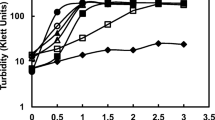Abstract
Growth yields and rates of 3 hyphomicrobia were improved by varying components of or adding compounds to medium 337. Methanol (0.5% v/v), and similarly methylamine·HCl (3.38g/l), were optimal among 22 C-sources tested; increasing the methylamine·HCl concentration to 5.07g/l gave higher Hyphomicrobium B-522 yields but also prolonged lag periods. Ten C-sources (organic acids, alcohols) stimulated growth slightly but significantly, even in subcultures. Sugar compounds were not utilized. Strains B-522 and ZV-580 were stimulated by l-lysine and gluconate, while NQ-521 gr was stimulated by aspartate.
N-Sources tested were inorganic (3), organic (3), or complex (3). (NH4)2SO4 (0.5g/l) was optimal for strains ZV-580 and NQ-521 gr, but Hyphomicrobium B-522 grew best with urea-N. With NH +4 , strain B-522 grew as homogeneous suspension, all other N-sources caused clumping and pellicle formation. Inorganic requirements (PO 3-4 , Mg, Ca, Fe, Mn, Mo) of strains B-522 and ZV-580 were optimized. Addition of Ni, Co, or Zn had no effect; metals “44” or Cu, resulted in growth inhibition.
Vitamin B12 stimulated Hyphomicrobium B-522; 2.5μg/l B12 decreased the doubling time from 9.3–10.8h to 5.4–5.8h. All combined single improvements resulted in a protein increase of 557% (B-522), 141% (NQ-521 gr), or 109% (ZV-580), respectively.
Similar content being viewed by others

References
Anthony C (1975) The microbial metabolism of C-1 compounds (The cytochromes of Pseudomonas AM1). Biochem J 146:289–298
Attwood MM, Harder W (1977) Isocitrate lyase activity in Hyphomicrobium spp: A critical reappraisal. FEMS Microbiol Lett 1:25–30
Harder W, Attwood MM (1978) Biology, physiology and biochemistry of hyphomicrobia. Adv Microbial Physiol 17:303–359
Hirsch P (1974) Budding bacteria. Ann Rev Microbiol 28:391–444
Hirsch P, Conti SF (1964a) Biology of budding bacteria I. Enrichment, isolation and morphology of Hyphomicrobium spp. Arch Mikrobiol 48:339–357
Hirsch P, Conti SF (1964b) Biology of budding bacteria II. Growth and nutrition of Hyphomicrobium spp. Arch Mikrobiol 48:358–367
Hirsch P, Jones HE (1968) DNA location, hyphal growth and life cycle of a budding bacterium, Hyphomicrobium spec, strain B-522. Bact Proc G 149
Hutner SH (1972) Inorganic nutrition. Ann Rev Microbiol 26:313–343
Kaffka A (1960) Stoffwechselphysiologische Untersuchungen an Hyphomicrobium vulgare Stutzer et Hartleb. Diss Univ Hamburg
Large PJ, Peel D, Quayle JR (1961) Microbial growth on C-1 compounds. 2. Synthesis of cell constituents by methanol and formategrown Pseudomonas AM1, and methanol- grown Hyphomicrobium vulgare. Biochem J 81:470–480
Lowry OH, rosebrough NJ, Farr AL, Randall RJ (1951) Protein measurement with the Folin phenol reagent. J Biol Chem 193:265–275
Mehta RJ (1978) Effect of exogeneous organic compounds on growth of the obligate methylotroph. J Gen Appl Microbiol 24:255–259
Meiberg JBM, Bruinenberg PM, Harder W (1980) Effect of dissolved oxygen tension on the metabolism of methylated amines on Hyphomicrobium X in the absence and presence of nitrate: evidence for “aerobic” denitrification. J Gen Microbiol 120:453–463
Mevius Jr., W (1953) Beitrage zur Kenntnis von Hyphomicrobium vulgare Stutzer et Hartleb. Arch Mikrobiol 19:1–29
Moore RL, Hirsch P (1973) First generation synchrony of isolated Hyphomicrobium swarmer populations. J Bacteriol 116:418–423
Shishkina VN, Trotsenko YuA (1974) Characterization of a new Hyphomicrobium strain utilizing one carbon compounds. Microbiol USSR 43:653–657
Smith AJ, Hoare DS (1977) Specialist phototrophs, lithotrops, and methylotrophs: a unity among a diversity of procaryotes? Bacteriol Rev 41:419–448
Sperl GT, Hoare DS (1971) Denitrification with methanol: a selective enrichment for Hyphomicrobium species. J Bacteriol 108:733–736
Staley JT (1968) Prosthecomicrobium and Ancalomicrobium: new prosthecate freshwater bacteria. J Bacteriol 95:1921–1942
Stutzer A, Hartleb R (1898) Untersuchungen über die bei der Bildung von Salpeter beobachteten Mikroorganismen. (I. Abhandlung) Mitt landw Inst Königl Univ Breslau 1:75–100
Van Ert M, Staley JT (1971) Gas vacuolated strains of Microcyclus aquaticus. J Bacteriol 108:236–240
Wilkinson TG, Hamer G (1972) Some growth characteristics of a Hyphomicrobium sp in batch culture. J Appl Bacteriol 35:577–588
Zavarzin GA (1960) The life cycle and nuclear apparatus in Hyphomicrobium vulgare Stutzer et Hartleb. Microbiol USSR 29:24–27
Author information
Authors and Affiliations
Rights and permissions
About this article
Cite this article
Matzen, N., Hirsch, P. Improved growth conditions for hyphomicrobium sp. B-522 and two additional strains. Arch. Microbiol. 131, 32–35 (1982). https://doi.org/10.1007/BF00451495
Received:
Accepted:
Issue Date:
DOI: https://doi.org/10.1007/BF00451495



